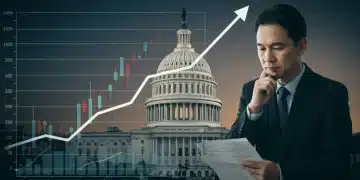U.S. Trade Policy Updates 2025: New Tariffs Impact Import/Export

U.S. trade policy updates in 2025 are poised to introduce new tariffs, directly affecting import/export businesses and global supply chains. Understanding these changes is critical for strategic planning.
As 2025 approaches, businesses are closely monitoring impending changes to U.S. Trade Policy Updates in 2025: How New Tariffs Could Affect Import/Export Businesses. The landscape of international commerce is set for significant shifts, with potential new tariffs on the horizon that could redefine operational strategies for companies engaged in cross-border trade.
Anticipated Tariff Structures for 2025
The U.S. government is signaling potential adjustments to its tariff regime for 2025, a move that could significantly reshape import and export operations. These proposed changes stem from a combination of domestic economic priorities and evolving geopolitical considerations, aiming to protect specific industries or address perceived unfair trade practices.
While specifics are still emerging, early indications suggest a targeted approach rather than broad, sweeping tariffs. Certain sectors, particularly those deemed critical for national security or domestic manufacturing resilience, are likely to see increased protectionist measures. This could mean higher costs for importers in these areas and potential competitive advantages for domestic producers.
Key Sectors Under Scrutiny
Several industries are currently under review for potential tariff increases. These include:
- Advanced Technologies: Components for AI, semiconductors, and telecommunications equipment.
- Green Energy Products: Solar panels, electric vehicle batteries, and wind turbine parts.
- Strategic Minerals: Rare earth elements and other materials vital for high-tech manufacturing.
Conversely, some sectors might experience tariff reductions or exemptions, particularly if they are critical for consumer goods or if the U.S. seeks to strengthen trade relationships with specific allies. The fluidity of these discussions underscores the need for businesses to remain agile and informed.
Economic Impact on Import Businesses
For U.S. import businesses, new tariffs in 2025 could translate directly into increased operational costs. These added expenses will likely be absorbed by importers, passed on to consumers, or a combination of both, leading to potential price hikes for imported goods across various categories.
Companies reliant on international supply chains will face pressure to reassess their sourcing strategies. Diversifying suppliers to countries not subject to new tariffs, or even reshoring production, could become more attractive alternatives. This strategic shift, however, often entails significant upfront investment and logistical complexities.
Supply Chain Reconfiguration
The immediate consequence for many importers will be a thorough review of existing supply chains. The goal is to mitigate the financial impact of tariffs and ensure continuity of supply.
- Supplier Diversification: Exploring new markets for raw materials and finished goods.
- Reshoring/Nearshoring: Bringing production closer to home or to neighboring countries to reduce reliance on distant, tariff-affected regions.
- Inventory Management: Adjusting inventory levels to account for potential delays or cost increases.
Moreover, the administrative burden of navigating new tariff schedules and customs procedures could increase, requiring additional resources for compliance and documentation. Small and medium-sized enterprises (SMEs) might find these challenges particularly daunting without adequate preparation.
Challenges and Opportunities for Export Businesses
While import businesses brace for higher costs, U.S. export businesses could face a mixed bag of challenges and opportunities. New tariffs imposed by the U.S. might provoke retaliatory tariffs from trading partners, making American goods more expensive and less competitive abroad. This scenario could lead to reduced demand for U.S. exports in affected markets.
However, there’s also potential for new opportunities. If U.S. tariffs successfully bolster domestic industries, these sectors might become more robust and innovative, potentially increasing their capacity and competitiveness for export in the long run. Additionally, the U.S. government might offer incentives or subsidies to export-oriented businesses to offset any adverse effects of trade disputes.
Navigating International Markets
Export businesses will need to be strategic in identifying and penetrating new markets, especially if traditional markets become less viable due to retaliatory measures. Market research and strong diplomatic ties will play crucial roles.
Adaptability will be key for U.S. exporters. Companies selling goods to countries that impose retaliatory tariffs may need to adjust their pricing strategies, seek out new customer bases, or even explore manufacturing options overseas to circumvent trade barriers. The global trade environment demands continuous monitoring and flexible business models.
Regulatory Compliance and Documentation
Navigating the complex landscape of U.S. trade policy updates in 2025 will place a significant emphasis on regulatory compliance and meticulous documentation. Businesses involved in import and export activities must be prepared for potential changes in customs classifications, origin rules, and reporting requirements. Non-compliance can lead to hefty fines, delays in shipments, and reputational damage.
Staying abreast of the latest legal frameworks and understanding their implications will be paramount. Investing in specialized trade compliance software or engaging with trade consultants may become essential for many companies, especially those dealing with a high volume and variety of goods.

Essential Compliance Measures
Businesses should proactively review their internal processes to ensure they align with upcoming regulations. Key areas of focus include:
- Harmonized Tariff Schedule (HTS) Codes: Verifying the correct classification of goods under potentially revised codes.
- Rules of Origin: Ensuring accurate determination and documentation of a product’s country of origin, which directly impacts tariff rates.
- Customs Valuation: Proper valuation methods for imported goods to avoid discrepancies and penalties.
Detailed record-keeping will be critical for demonstrating due diligence and for successfully appealing any assessed duties or penalties. The shift in trade policy will not only be about tariffs but also about adapting to a more stringent regulatory environment.
Strategic Planning for Businesses in 2025
As the potential for new tariffs in 2025 looms, proactive strategic planning becomes indispensable for import/export businesses. Companies need to conduct comprehensive risk assessments, analyzing their exposure to various trade scenarios and identifying vulnerabilities within their current operational models. This includes evaluating the impact of potential tariffs on profit margins, cash flow, and overall competitiveness.
Developing contingency plans is also crucial. This might involve identifying alternative markets, exploring opportunities for product diversification, or even considering mergers and acquisitions to strengthen market position. Scenario planning, which involves forecasting outcomes under different tariff structures, can help businesses prepare for a range of possibilities and make informed decisions.
Key Strategic Considerations
Businesses should focus on several strategic areas to mitigate risks and capitalize on opportunities:
- Market Diversification: Reducing reliance on single markets for sourcing or selling.
- Technological Adoption: Leveraging automation and data analytics to optimize supply chains and compliance.
- Government Relations: Engaging with policymakers and trade associations to advocate for favorable trade policies.
Ultimately, the ability to adapt swiftly and strategically to changes in trade policy will differentiate resilient businesses from those that struggle. Companies that invest in robust planning and maintain flexibility will be better positioned to navigate the evolving global trade landscape.
Long-Term Implications for Global Trade
The U.S. trade policy updates in 2025, particularly the introduction of new tariffs, carries significant long-term implications for the global trade system. These measures could signal a broader trend towards protectionism, potentially leading to a fragmentation of global supply chains and a re-evaluation of international trade agreements. Countries may increasingly prioritize domestic production and seek to reduce dependence on foreign suppliers, fostering a more regionalized approach to commerce.
This shift could also accelerate the development of new trade blocs and alliances, as nations seek stable and predictable trading environments. The World Trade Organization (WTO) and other international bodies might face increased pressure to mediate disputes and adapt their frameworks to a more complex and potentially contentious global trade arena. The ripple effects will extend beyond economic indicators, influencing geopolitical relationships and international cooperation for years to come.
Shifting Global Dynamics
The long-term outlook suggests a reordering of global trade priorities and relationships. Key aspects include:
- Regionalization of Supply Chains: Increased focus on local or regional sourcing to enhance resilience.
- Digital Trade Norms: Growing importance of establishing rules for digital services and e-commerce amidst trade barriers for physical goods.
- Investment Patterns: Changes in foreign direct investment (FDI) as companies adjust to new trade incentives and disincentives.
The enduring impact of these policies will depend on their scope, duration, and the reactions of other major trading nations. Businesses must think beyond immediate adjustments and consider how these shifts will fundamentally alter the competitive landscape for decades.
Preparing for Policy Shifts and Uncertainty
Given the dynamic nature of trade policy, preparing for shifts and inherent uncertainty is a constant requirement for import/export businesses. The U.S. trade policy updates in 2025 highlight the need for continuous monitoring of legislative developments, political rhetoric, and economic indicators that could influence future tariff decisions. This proactive stance allows businesses to anticipate changes rather than merely react to them, providing a crucial competitive edge.
Building strong relationships with government affairs teams, industry associations, and legal counsel specializing in international trade can provide invaluable insights and support. These networks can offer early warnings about potential policy changes and guidance on compliance and advocacy efforts. Furthermore, investing in robust data analytics capabilities can help businesses model the potential impact of various policy scenarios, enabling more informed decision-making.
Mitigating Risks Through Adaptability
Embracing a culture of adaptability is perhaps the most critical element in preparing for policy shifts. This involves:
- Flexible Contracts: Negotiating supply and distribution agreements with clauses that allow for adjustments based on trade policy changes.
- Cross-Functional Teams: Establishing internal teams that can quickly assess and respond to new regulations, incorporating expertise from legal, logistics, finance, and procurement departments.
- Contingency Budgeting: Allocating resources to cover potential increases in duties, legal fees, or supply chain reconfigurations.
The ability to pivot operations, reconfigure supply chains, and adjust pricing strategies promptly will be vital. Companies that embed flexibility into their core business model will be better equipped to not only survive but thrive amidst the ongoing evolution of global trade policies.
| Key Point | Brief Description |
|---|---|
| New Tariffs Expected | U.S. government signals targeted tariff adjustments for 2025, impacting specific sectors. |
| Import Business Costs | Importers face increased costs, supply chain reconfigurations, and potential price hikes. |
| Export Challenges/Opportunities | Exporters may face retaliatory tariffs but could see long-term domestic industry growth. |
| Compliance Critical | Strict adherence to new customs codes, origin rules, and documentation is essential. |
Frequently Asked Questions About 2025 U.S. Trade Policy
The primary drivers are a combination of domestic economic priorities, such as protecting key industries and jobs, and evolving geopolitical considerations aimed at national security and addressing perceived unfair trade practices from other nations.
Industries involved in advanced technologies (e.g., semiconductors, AI components), green energy products (e.g., solar panels, EV batteries), and strategic minerals are currently under close scrutiny for potential tariff adjustments in 2025.
Import businesses can mitigate impacts by diversifying their supplier base to non-tariffed countries, exploring reshoring or nearshoring options, optimizing inventory management, and investing in robust trade compliance solutions and expertise.
Yes, U.S. export businesses could face challenges from retaliatory tariffs imposed by other countries, making American goods more expensive abroad. However, stronger domestic industries might also create new export opportunities in the long term.
The long-term outlook suggests a potential move towards increased protectionism, fragmentation of global supply chains, and a re-evaluation of international trade agreements. This could lead to more regionalized commerce and new trade alliances.
What Happens Next
As the U.S. trade policy updates for 2025 continue to unfold, businesses must remain vigilant. The coming months will likely bring more clarity on specific tariff schedules and affected goods, as government agencies finalize their assessments and engage in further international dialogues. Companies should prioritize ongoing monitoring of legislative announcements and engage with industry associations to share insights and strategize collective responses. The global trade environment is in flux, and adaptability will be the defining characteristic of successful import/export operations in the year ahead.





